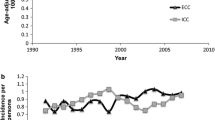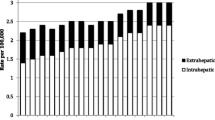Abstract
Purpose
An increasing incidence of cholangiocarcinoma (CCA) has been reported in Western countries, but evidence is lacking in Asia. We investigated the incidence of CCA in a nationwide cohort.
Patients and methods
We conducted a nationwide cohort study based on data from the Taiwan National Health Insurance Research Database (NHIRD) between 1998 and 2008. A total of 6,491 CCA patients were recruited. Adjusted incidences, cumulative incidences, and stratified analyses were used to detect trends regarding CCA incidence in Taiwan.
Results
The incidence of CCA increased by 2.01-fold, from 1.79 in 1998 to 3.60 in 2008 per 100,000 persons. For extrahepatic CCA, the incidence increased by 1.5-fold from 0.48 to 0.73 per 100,000. Intrahepatic CCA increased by 3.0-fold from 0.72 to 2.19 per 100,000. The rising incidence of CCA was observed across all sexes and ages, especially in those older than 65 years of age. The proportion of CCA patients who underwent surgery and the overall survival rates remained stable.
Conclusions
The incidence of both intrahepatic and extrahepatic CCA increased significantly between 1998 and 2008. Rising trends were observed among different ages and sexes, especially in the elderly population.


Similar content being viewed by others

References
Parkin DM, Ohshima H, Srivatanakul P, et al. Cholangiocarcinoma: epidemiology, mechanisms of carcinogenesis and prevention. Cancer Epidemiol Biomarkers Prev 1993;2:537–544
Shin HR, Oh JK, Masuyer E, et al. Epidemiology of cholangiocarcinoma: an update focusing on risk factors. Cancer Sci 2010;101:579–585
Blechacz B, Gores GJ. Cholangiocarcinoma: advances in pathogenesis, diagnosis, and treatment. Hepatology 2008;48:308–321
Patel T. Increasing incidence and mortality of primary intrahepatic cholangiocarcinoma in the United States. Hepatology 2001;33:1353–1357
Shaib YH, Davila JA, McGlynn K, et al. Rising incidence of intrahepatic cholangiocarcinoma in the United States: a true increase? J Hepatol 2004;40:472–477
McGlynn KA, Tarone RE, El-Serag HB. A comparison of trends in the incidence of hepatocellular carcinoma and intrahepatic cholangiocarcinoma in the United States. Cancer Epidemiol Biomarkers Prev 2006;15:1198–1203
West J, Wood H, Logan RF, et al. Trends in the incidence of primary liver and biliary tract cancers in England and Wales 1971–2001. Br J Cancer 2006;94:1751–1758
Alvaro D, Crocetti E, Ferretti S, et al. Descriptive epidemiology of cholangiocarcinoma in Italy. Dig Liver Dis 2010;42:490–495
Mouzas IA, Dimoulios P, Vlachonikolis IG, et al. Increasing incidence of cholangiocarcinoma in Crete 1992–2000. Anticancer Res 2002;22:3637–3641
Luke C, Price T, Roder D. Epidemiology of cancer of the liver and intrahepatic bile ducts in an Australian population. Asian Pac J Cancer Prev 2010;11:1479–1485
Welzel TM, McGlynn KA, Hsing AW, et al. Impact of classification of hilar cholangiocarcinomas (Klatskin tumors) on the incidence of intra- and extrahepatic cholangiocarcinoma in the United States. J Natl Cancer Inst 2006;98:873–875
The National Health Research Institutes of Taiwan. National Health Insurance Research Database. http://nhird.nhri.org.tw/en/
Rachel Lu JF, Chiang TL. Evolution of Taiwan’s health care system. Health Econ Policy Law 2011;6:85–107
Wu CY, Wu CH, Wu MS, et al. A nationwide population-based cohort study shows reduced hospitalization for peptic ulcer disease associated with H pylori eradication and proton pump inhibitor use. Clin Gastroenterol Hepatol 2009;7:427–431
Wu CY, Wu MS, Kuo KN, et al. Effective reduction of gastric cancer risk with regular use of nonsteroidal anti-inflammatory drugs in Helicobacter pylori-infected patients. J Clin Oncol 2010;28:2952–2957
Shaib Y, El-Serag HB. The epidemiology of cholangiocarcinoma. Semin Liver Dis 2004;24:115–125
Okuda K, Nakanuma Y, Miyazaki M. Cholangiocarcinoma: recent progress. Part 1: epidemiology and etiology. J Gastroenterol Hepatol 2002;17:1049–1055
Patel T. Worldwide trends in mortality from biliary tract malignancies. BMC Cancer 2002;2:10
Gatto M, Bragazzi MC, Semeraro R, et al. Cholangiocarcinoma: update and future perspectives. Dig Liver Dis 2010;42:253–260
Shaib YH, Davila JA, Henderson L, et al. Endoscopic and surgical therapy for intrahepatic cholangiocarcinoma in the United States: a population-based study. J Clin Gastroenterol 2007;41:911–917
El-Serag HB, Engels EA, Landgren O, et al. Risk of hepatobiliary and pancreatic cancers after hepatitis C virus infection: a population-based study of U.S. veterans. Hepatology 2009;49:116–123
Shaib YH, El-Serag HB, Davila JA, et al. Risk factors of intrahepatic cholangiocarcinoma in the United States: a case–control study. Gastroenterology 2005;128:620–626
Tyson GL, El-Serag HB. Risk factors for cholangiocarcinoma. Hepatology 2011;54:173–184
Ustundag Y, Bayraktar Y. Cholangiocarcinoma: a compact review of the literature. World J Gastroenterol 2008;14:6458–6466
Voyles CR, Smadja C, Shands WC, Blumgart LH. Carcinoma in choledochal cysts. Age-related incidence. Arch Surg 1983;118:986–988
Lee CC, Wu CY, Chen GH. What is the impact of coexistence of hepatolithiasis on cholangiocarcinoma? J Gastroenterol Hepatol 2002;17:1015–1020
Acknowledgements
Financial support by Taiwan National Health Research Institutes (Grant number: PH-100-PP54) and Taichung Veterans General Hospital (Grant number: TCVGH-1003303C).
Author information
Authors and Affiliations
Corresponding author
Electronic supplementary material
Below is the link to the electronic supplementary material.
12072_2012_9369_MOESM1_ESM.pdf
Supplementary Fig. 1 The proportion of patients with overall biliary cholangiocarcinoma who received operation (OP) on the liver between 1998 and 2008. (PDF 9 kb)
12072_2012_9369_MOESM2_ESM.pdf
Supplementary Fig. 2 The 1-year, 2-year and 3-year cumulative mortality rates of patients with overall biliary cholangiocarcinoma between 1998 and 2008. (PDF 10 kb)
Rights and permissions
About this article
Cite this article
Lee, TY., Lin, JT., Kuo, K.N. et al. A nationwide population-based study shows increasing incidence of cholangiocarcinoma. Hepatol Int 7, 226–232 (2013). https://doi.org/10.1007/s12072-012-9369-0
Received:
Accepted:
Published:
Issue Date:
DOI: https://doi.org/10.1007/s12072-012-9369-0



